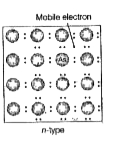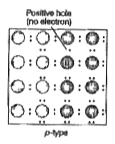What is a semiconductor? What are n-type and p-type semiconductors?
Text Solution
The solids which exhibits intermediate conductivities ranging from 1−8 10−4Omea−1m−1 are known as semiconductors. In this case, the gap between the valence band and conduction band is small. Therefore, some of the electrons may jump from valence band to conduction band and some conductivity is observed. Pure substances like silicon and germanium exhibit conducting behaviour and are called intrinsic semiconductors. On the basis of impurities added for doping, semiconductors are of two types.
(a) n-type Semiconductor When a silicon or Mobile electron germanium crystal is doped with group 15 elements like P or As, the dopant atoms with five valence some of the lattice sites normally occupied by silicon atom. n-type The dopant atom uses four of its electrons for covalent bonding but the fifth extra electron becomes delocalised and this extra electron increases the conductivity of Si crystal. Hence, silicon doped with electron rich impurity is called n-type semiconductor.

(b) p-type Semiconductor When a silicon or germanium crystal is doped with group 13 elements like B, Alor Ga which contains only three valence electrons, the dopant atoms occupy some of the lattice sites normally occupied by silicon atoms.

The place, where the fourth valence electron is missing is called electron hole or electron vacancy. These holes can move through the crystal like a positive charge and increase the conductivity of Si crystal.
Hence, silicon doped with electron deficient impurity is called p-type semiconductor
|
Similar Questions
Knowledge Check
Bond in n and p-type semiconductor is
AcovalentBionicCmetallic bondDco-ordinate bondBond in n and p type semiconductor is
AcovalentBionicCmettalic bondDco-ordinate bond
What are n-type semiconductors ?
View SolutionWhat are n-type semiconductors ?
View SolutionWhat is a semiconductor ? Mention the two main types of semiconductor.
View SolutionWhat is a semiconductor ? Describe the two main types of semiconductors.
View SolutionWhat is a semiconductor ? Describe the two main types of semiconductors.
View SolutionWhat is the difference between n-type and p-type semiconductor?
View Solution
